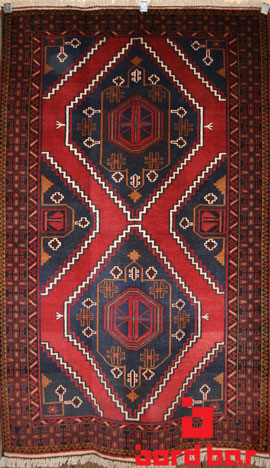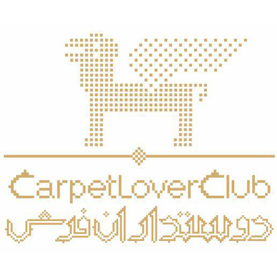balouch handmade carpet review: mix of geometrical patterns and cooked colors
types of knotting in persian handmade carpet and knot counting methods
June 26, 2018types of persian handmade kilims by geometrical patterns
June 27, 2018
The most dominant feature of Baluch(Balouch) rugs is a pattern formed by the repetition of highly stylized camel’s foot- or pear-shaped medallions surrounded on all sides by geometric borders. The result is a very geometric and intricate design that borrows largely from TURKMEN style, especially in the use of the “gul” motif. Baluch (Balouch) rugs are of excellent quality. They last for many years. Baluch(Balouch) rugs are usually small (2 x 3 to 4 x 6 feet). Larger sizes exist, but are hard to find. Finished rugs are nearly square. Dark red or blue contrasted with splashes of white, yellow and orange. Powerful blues predominate, with ivory as a contrasting color. They have Soft wool, thin, tight pile texture and the foundation of the majority of Baluch(Balouch) rugs comes from two areas:
- The Taimani Tribe in Afghanistan
- The Baluch Tribes from IRAN
BALUCH rugs from IRAN have white cotton or grey wool foundations. Goat hair is also a common warp material in many Baluch(Balouch) rugs. Baluch(Balouch) rugs are made of soft wool, are loosely woven, and are colored with corrosive black/brown dyes. Baluch(Balouch) weavers use almost exclusively the asymmetrical Persian knot. Knots tend to be small and tightly packed down.
A distinct group of carpets, woven by Baluch (بلوچ) tribes in the northeastern Iranian province of Khorasan and the Sīstān area, is known as Baluch carpets. These carpets were not, as is frequently erroneously assumed, made in Makrān, where the main body of the Baluch tribes live. In addition to the Baluch, many other ethnic groups in Khorasan weave carpets that look like the Baluch carpets and are designated as such.
Baluch (rug origin & description)

The province of Balochistan, the home of the Baluch rug (also Belouch, Balouch or Balooch), borders the south-east of Kerman is host to many Turkish tribes who settled in the region centuries ago to tend their flock. Belouch rugs are closely related to Turkman rugs, in fact they are technically Turkman pieces only Turkman rugs are differentiated due to their very high quality. The Balochi people find their home in western Pakistan, south-east Iran and the south of Afghanistan. Camels are important to Baluchi tribes and the camel print, as well as (very occasionally) camel hair, is used in the creation of their rugs. Baluch rugs can be made on a foundation of cotton or wool, goat hair is often used in the weft. Baluchi rugs are soft and flexible yet extremely resilient and have a real feeling of age and history behind them. They are sought after in the West due to their tribal appeal. Baluch rugs are limited in size due to their tribal origins, woven on horizontal looms the maximum length is normally around 2-2.5 meters. Baluch rugs are excellent value for money.
The main characteristics of carpets in the Baluch tradition

The use of dark colors like dark blue or blue-black, dark brownish red, dark reddish brown, dark brown verging on black (mainly for outlines), dark purplish brown, dark brownish violet, and occasionally some ivory is characteristic. Because of the almost black outlines the dark colors appear even darker. These carpets thus possess a somber charm that appeals to many connoisseurs and collectors. Camel hair is sometimes woven into the niches (meḥrāb) of Baluch prayer carpets. These rugs are less somber, even occasionally light in ground color. The idea that this material is actually wool dyed with walnut husks is incorrect; it is undyed camel hair. Occasionally a few old carpets are found with ivory fields; most of them come from the Qāʾenāt and Sīstān areas. They sometimes seem more colorful than the normal Baluch carpets.

Because of the prevalence of ornaments like rectangles, hexagons, and octagons, Baluch carpets belong to the geometric category of nomad carpets. Repeated or alternating lozenges and medallions, in regular or offset rows, play an extremely important role in the design of these carpets. Frequently the rows create a honeycomb pattern, so that the ground color of the field is no longer distinguishable. Indeed, this feature is characteristic of Baluch carpets. Plant motifs also occur in the Baluch repertoire of forms, but they have been rendered angular and geometric. The nomenclature and meaning of Baluch motifs are not very well known. Statements in the carpet literature that the craftsmen did not understand what they were weaving are incorrect. Such statements are a sign of retreat before the extraordinarily difficult problems of research in this area. Such complex questions cannot be understood or explained through quick investigations. Rather, they require years of arduous study in the field, which have not yet taken place.
Baluch carpets are all knotted with the asymmetrical knot, that is, the so-called “Persian or Senna knot,” open to the left. In traditional pieces the warp (tār) always consists of two-ply wool, Z-spun and S-twisted (čap-o-rāst rīsīda), and is light in color. In newer pieces the warp can also be of cotton. The weft (pūd) of Baluch carpets consists of two sinuous brown or dark brown shoots, contrary to C. A. All Baluch carpets are single-wefted. On rare occasions the first weft is drawn taut, thus creating a difference in levels, as for example in the Kurd Baluch. The weft is usually two-ply, Z-spun, and loosely twisted. Frequently, however, the weft can be a single strand. The pile is also two-ply, Z-spun and loosely twisted. Many Baluch carpets, for example, the Sālār-ḵānī from the area of Torbat-e Ḥaydarī, include some silk in the pile of wedding and dowry carpets. This material is extremely expensive for the Baluch and represents the ultimate in luxury. They must buy or barter for the silk because they do not themselves manufacture it.
One of the most notable characteristics of Baluch carpets is the way in which their selvedges are handled. These can be up to 2 cm wide; the material is dark brown or black goat hair. In rare instances the selvedges may be worked in a form of braiding with supplementary wefts. Usually, however, they are produced by passing the supplementary wefts over and under groups of four or more warps two, three, or four times, thus creating respectively double-, triple-, or quadruple-corded selvedges.

The Baluch, like many other nomads, manufacture a number of objects in pile or flat-woven technique, which serve different functions. Such products include double saddlebags (ḵorjīn, asb-jol; cushion covers (bāleš); saddle covers (rūzīnī); horse blankets (rū-asbī); ground covers on which meals are served (sofra); weavings for catching flour as it comes from the mill (sofra-ye ārd); bags for special purposes (dārāk); donkey chest bands (gūr-band); blinders for donkeys, horses, and camels (čašm-bandān); etc.
Although there is general knowledge of the characteristics mentioned, it is nevertheless extremely difficult to attribute carpets to specific makers (tribes, subtribes, clans, etc.) and regions (Khorasan and Sīstān, Saraḵs, Torbat-e Ḥaydarī, etc.). The main reason is that there are almost no detailed publications on Baluch carpets, in contrast, for example, to Turkman carpets, on which there are many Russian field studies. Besides, it is still not known even which tribes and subtribes produce carpets at all. The single published includes only a list of tribes that manufacture knotted-pile carpets. These tribes are as follows: ʿAlī Akbar-ḵānī from the Qāʾenāt region; ʿAbd-al-Sorḵ from the area around Saraḵs, Nīšāpūr, and Sabzavār; ʿAlī Mīrzāʾī, from the Saraḵs area; Bahlūlī (or Bahlūrī) from the vicinity of Ḵᵛāf, Jangal, and Torbat-e Ḥaydarī; the Bāyazīdī from around Maḥvalāt and Torbat-e Ḥaydarī; the Jān-Begī from the area of Rošḵᵛar and Torbat-e Ḥaydarī; the Jān-Mīrzāʾī from the Torbat-e Ḥaydarī district
